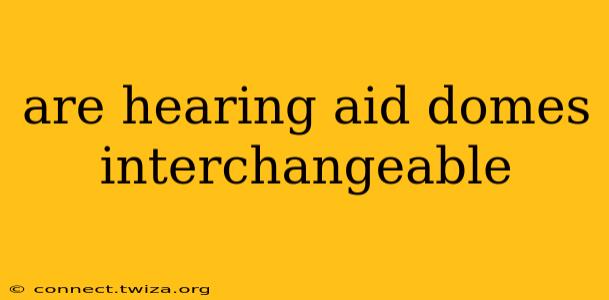Hearing aid domes are the small, soft silicone or rubber tips that fit over the end of your hearing aid's sound tube, creating a seal in your ear canal. Many people wonder if these domes are interchangeable between different hearing aids, and the answer is nuanced. While some domes might seem similar, interchangeability is not guaranteed and is generally not recommended. This guide will explore the intricacies of hearing aid dome compatibility and why sticking with the domes prescribed by your audiologist is crucial for optimal hearing and hearing aid performance.
What Determines Hearing Aid Dome Compatibility?
The compatibility of hearing aid domes depends on several factors, making simple swapping potentially problematic:
-
Hearing Aid Model: Different hearing aid manufacturers use unique designs and sizing systems. Even if two hearing aids appear visually similar, their sound tube diameters and dome attachment mechanisms might vary significantly. Forcing an incompatible dome onto a hearing aid could damage the device.
-
Dome Size and Shape: Domes are sized using a specific numbering system by the manufacturer. Even within a brand, a size "4" dome might not be identical across all models. Similarly, domes come in various shapes (e.g., standard, small, large, vented) to accommodate different ear canal anatomies. Using the wrong size or shape could lead to poor sound quality, discomfort, or even feedback.
-
Dome Material: Domes are usually made of silicone or rubber, sometimes with different levels of softness or flexibility. Different materials interact differently with the hearing aid's sound tube, influencing the sound transmission and seal. A dome of a different material might not create a proper seal or could degrade the hearing aid's performance.
-
Venting: Some domes have tiny vents to allow air to escape, which can be beneficial for reducing occlusion (the feeling of fullness or pressure in the ear). Using a vented dome on a hearing aid not designed for venting, or vice versa, could impact sound quality and comfort.
Can I Use Domes from a Different Brand of Hearing Aid?
No. It's extremely unlikely that domes from different hearing aid brands will be interchangeable. Each manufacturer has its own specifications and fitting systems, making cross-brand compatibility highly improbable. Attempting to use a dome from a different brand is strongly discouraged, as it can damage your hearing aid.
What Happens If I Use the Wrong Hearing Aid Domes?
Using the wrong domes can lead to several undesirable outcomes:
-
Poor Sound Quality: A poorly fitting dome will not create a proper seal, leading to reduced sound clarity, muffled sounds, and potential whistling or feedback.
-
Discomfort: An incorrectly sized or shaped dome can cause discomfort, pain, or irritation in the ear canal.
-
Hearing Aid Damage: Forcing an incompatible dome onto the hearing aid can damage the sound tube or other components.
-
Reduced Hearing Aid Lifespan: Improper dome usage can contribute to the premature wear and tear of your hearing aid.
How to Ensure I Use the Correct Domes?
The best way to ensure you're using the correct domes is to consult with your audiologist or hearing healthcare professional. They will assess your ear canal and hearing aid, then recommend the appropriate dome type and size. They also have access to a wider variety of domes ensuring proper fit and functionality.
What if I Lose or Damage a Hearing Aid Dome?
If you lose or damage a hearing aid dome, don't attempt to replace it with a dome from another hearing aid. Instead, contact your audiologist or hearing healthcare provider to get replacements. They'll ensure you receive the correct domes to maintain optimal hearing aid performance and prevent any damage to your device.
Why Should I Only Use Domes Recommended by My Audiologist?
Your audiologist's recommendation ensures the best possible fit, sound quality, and comfort. Using the wrong domes could compromise all of these, affecting your hearing experience and potentially damaging your expensive hearing aid. The time and effort invested in ensuring proper fit and selection are not to be underestimated.
By following these guidelines, you can safeguard your hearing and your hearing aids, ensuring you get the maximum benefit from your investment. Remember, a proper fit is paramount to effective hearing amplification.
